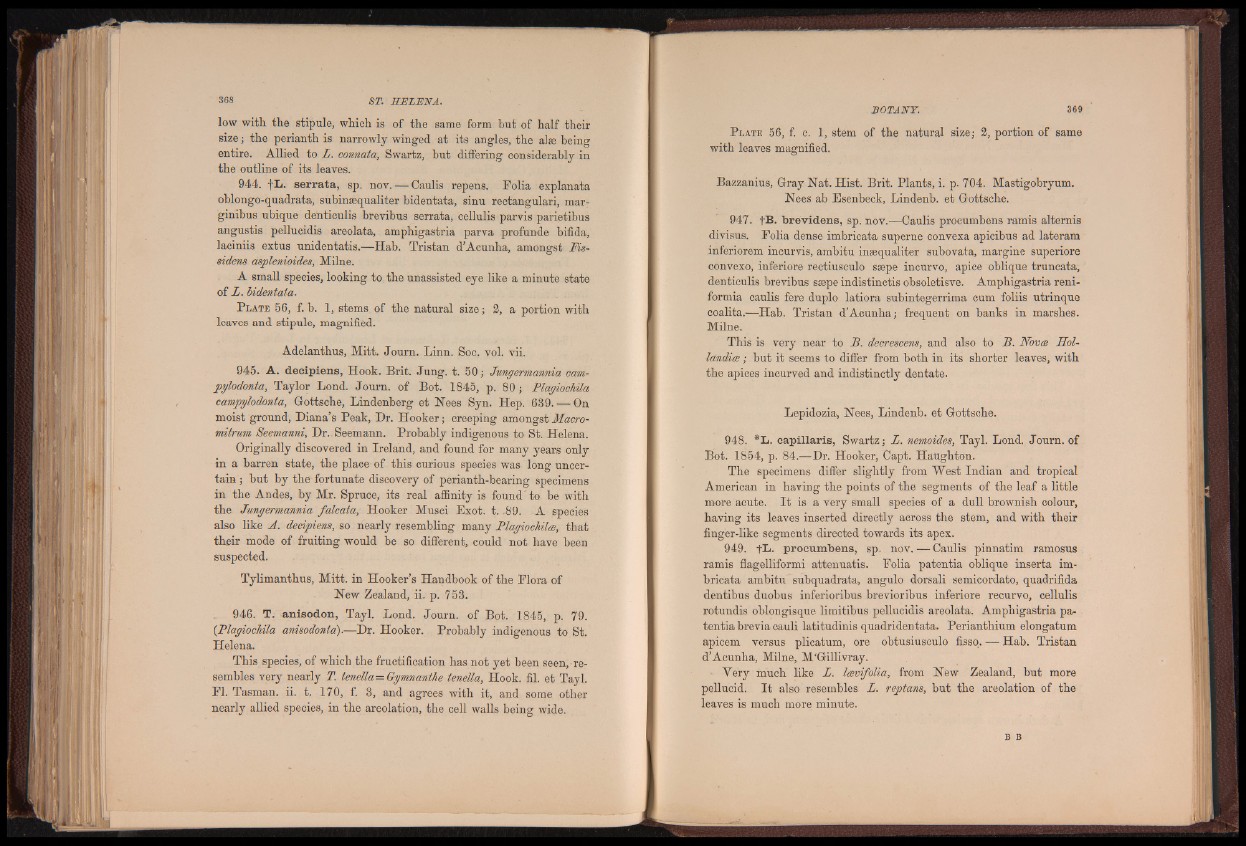
low with the stipule, which is of the same form but of half their
size; the perianth is narrowly winged at its angles, the alse being
entire. Allied to L. connata, Swartz, but differing considerably in
the outline of its leaves.
944. fli. se rra ta , sp. nov. — Caulis repens. Folia explanata
oblongo-quadrata, subinaequaliter bidentata, sinu rectangulari, mar-
ginibus ubique denticulis brevibus serrata, cellulis parvis parietibus
angustis pellucidis areolata, amphigastria parva profunde bifida,
laciniis extus unidentatis.—Hab. Tristan d’Acunha, amongst; Ms-
sidens asplenioides, Milne.
A small species, looking to the unassisted eye like a minute state
of L. bidentata.
P l a t e 5 6 , f. b . 1 , s t e m s o f t h e n a t u r a l s i z e ; 2 , a p o r t io n w i t h
le a v e s a n d s t i p u l e , m a g n i f ie d .
Adelanthus, Mitt. Journ. Linn. Soc, vol. vii.
945. A. decipiens, Hook. Brit. Jung. t. 50; Jungermannia cam-
pylodonta, Taylor Lond. Journ. of Bot. 1845, p. 80; Plagiockila
campylodonta, Gottsche, Lindenberg et Nees Syn. Hep, 639. — Gn
moist ground, Diana’s Peak, Dr. Hooker; creeping amongst Macro-
mitrum Seemanni, Dr. Seemann. Probably indigenous to St. Helena.
Originally discovered in Ireland, and found for many years only
in a barren state, the place of this curious species was- long uncerta
in ; but by the fortunate discovery of perianth-bearing specimens
in the Andes, by Mr. Spruce, its real affinity is found to be with
the Jungermannia falcata, Hooker Musci Exot. t. .89. A species
also like A. decipiens, so nearly resembling many Plagiocldlce, that
their mode of fruiting would be so different, could not have been
suspected.
Tylimanthus, Mitt, in Hooker’s Handbook of the Flora of
Hew Zealand, ii. p. 753.
946. T. anisodon, Tayl. Lond. Journ. of Bot. 1845, p. 79.
(PlagiocMla anisodonta).—Dr. Hooker. Probably indigenous to St.
Helena.
This species, of which the fructification has not yet been seen, resembles
very nearly T. tenella=GymnantJie tenella, Hook. fil. et Tayl.
FI. Tasman, ii. t, 170, f. 3, and agrees with it, and some other
nearly allied species, in the areolation, the cell walls being wide.
P la t e 56, f. c. 1, stem of the natural size; 2 , portion of same
with leaves magnified.
Bazzanius, Gray Nat. Hist. Brit. Plants, i. p. 704. Mastigobryum.
Nees ab Esenbeck, Lindenb. et Gottsche.
947. fB. brevidens, sp. nov.—Caulis procumbens ramis alternis
divisus. Folia dense imbricata superne convexa apicibus ad lateram
inferiorem incurvis, ambitu inæqualiter subovata, margins superiore
cônvexo, inferiore rectiusculo sæpe incurvo, apice oblique truncata,
denticulis brevibus sæpe indistinctis obsoletisve. Amphigastria reni-
formia caulis fere duplo latiora subintegerrima cum foliis utrinque
coalita.—Hab. Tristan d’Acunha; frequent on banks in marshes.
Milne.
This is very near to B. decrescens, and also to B. Novoe Hol-
lündioe ; but it seems to differ from both in its shorter leaves, with
the apices incurved and indistinctly dentate.
Lepidozia, Nees, Lindenb. et Gottsche.
948. *Ii. capillaris, Swartz ; L. nemoides, Tayl. Lond. Journ, of
Bot. 1854, p. 84.—Dr. Hooker, Capt. Haughton.
The specimens differ slightly from West Indian and tropical
American in having the points of the segments of the leaf a little
more acute. I t is a very small species of a dull brownish colour,
having its leaves inserted directly across the stem, and with their
finger-like segments directed towards its apex.
949. fli. procumbens, sp. nov. — Caulis pinnatim ramosus
ramis flagelliformi attenuatis. Folia patentia oblique inserta imbricata
ambitu subquadrata, angulo dorsali semicordato, quadrifida
dentibus duobus inferioribus brevioribus inferiore recurvo, cellulis
rotundis oblongisque limitibus pellucidis areolata. Amphigastria patentia
brevia cauli latitudinis quadridentata. Perianthium elongatum
apicem versus plicatum, ore obtusiusculo fisso. — Hab. Tristan
d’Acunha, Milne, M'Gillivray.
- Yery much like L. Icevifolia, from New Zealand, but more
pellucid. I t also resembles L. reptans, but the areolation of the
leaves is much more minute.
B B